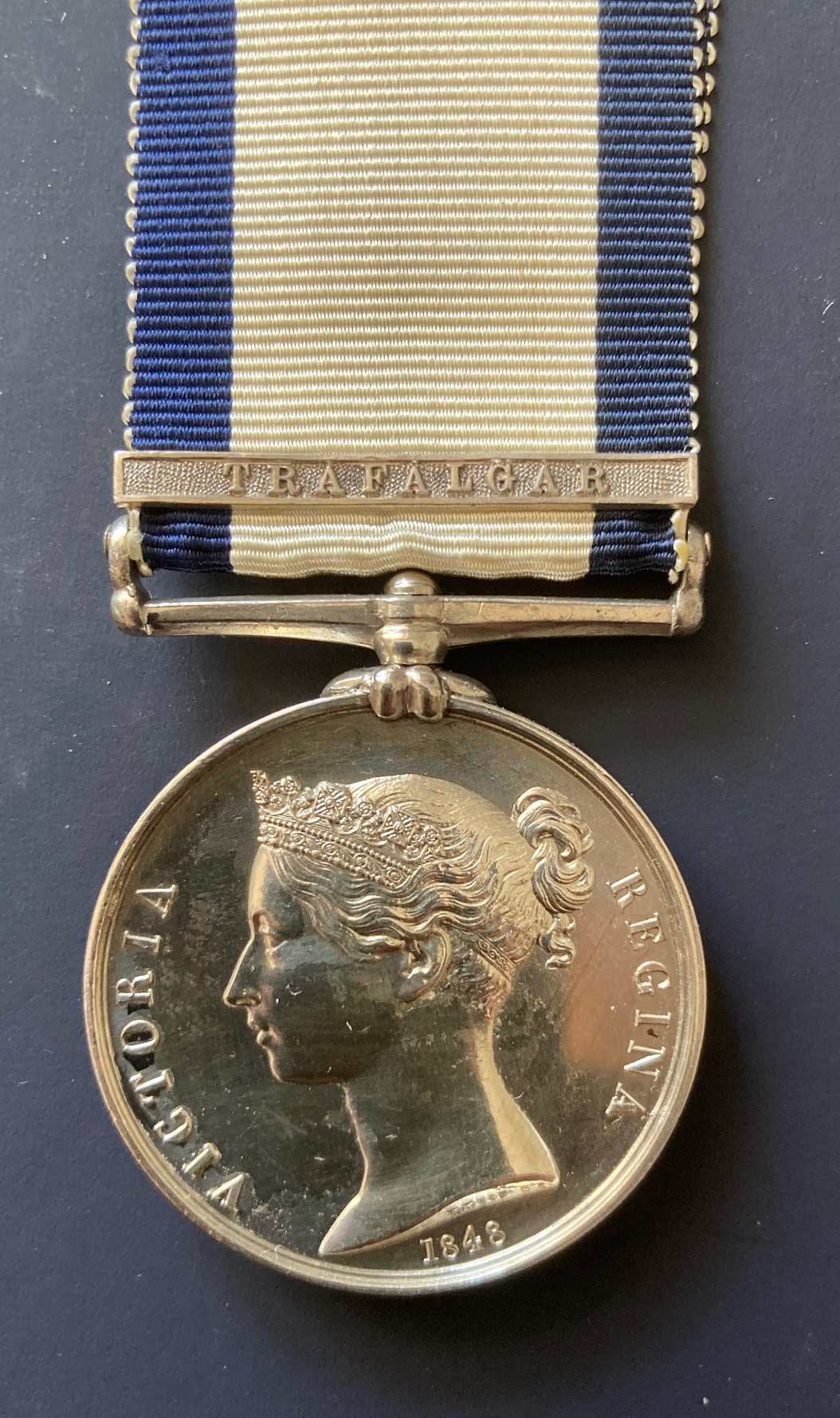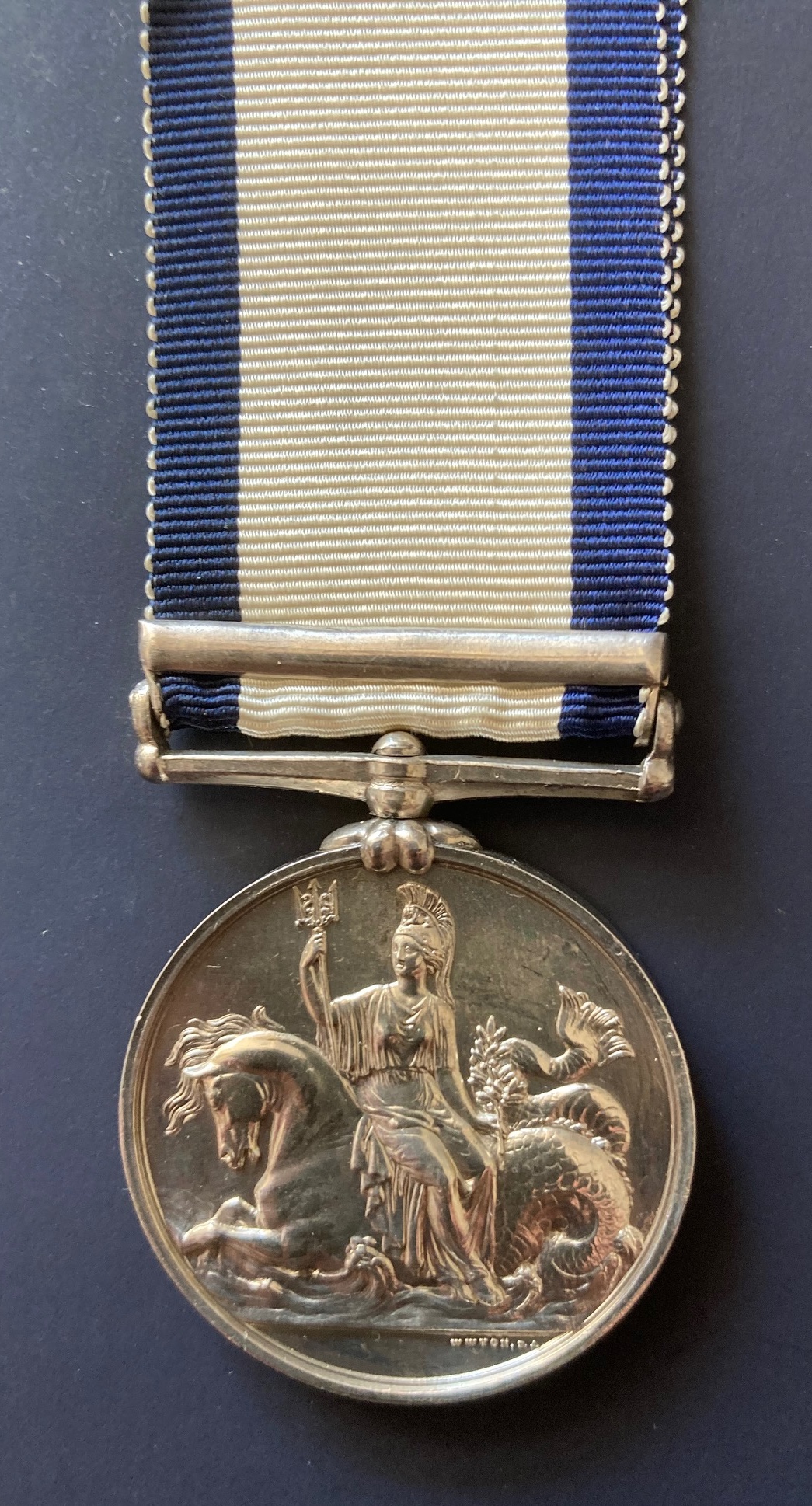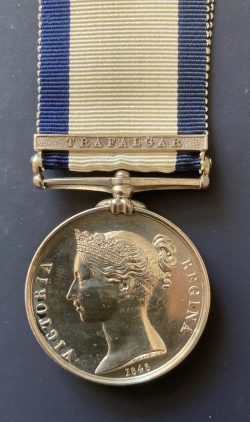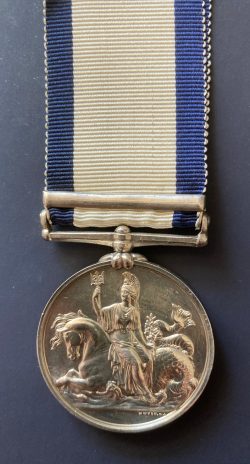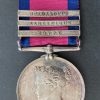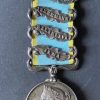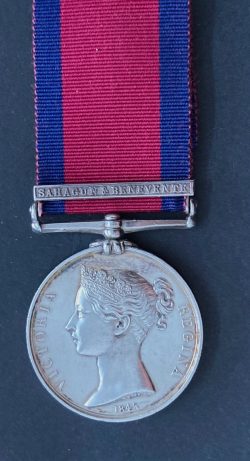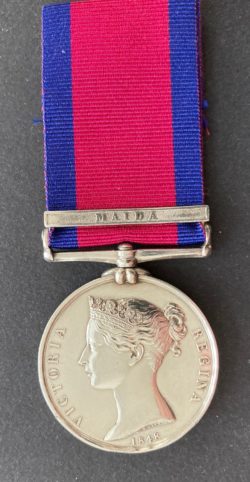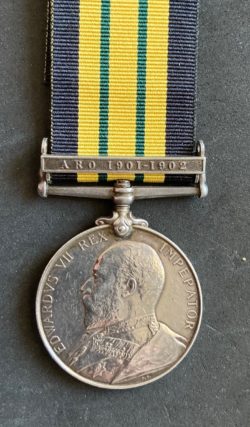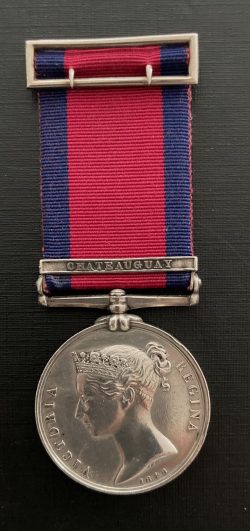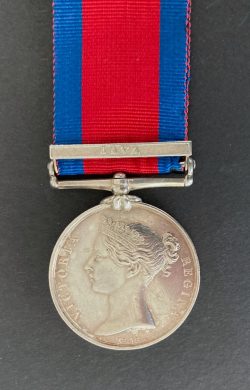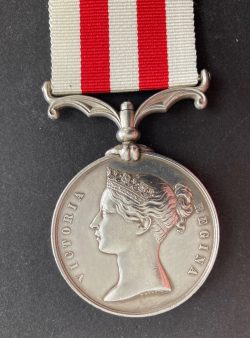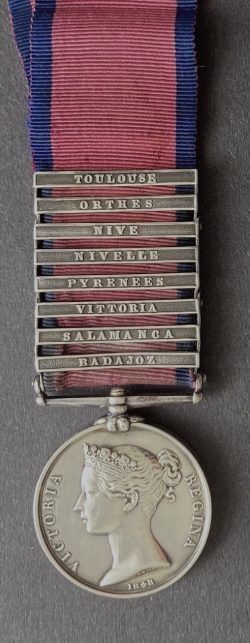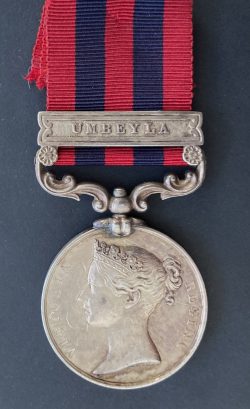Subtotal: £12,850.00
Naval General Service Medal clasp Trafalgar awarded to Admiral Hugh Patton, Royal Navy, who served as a Midshipman on board the Bellerophon at the battle . Of the finest ships at the battle , ‘The Billy Ruffian’ engaged against several of the enemy ships and then locked together in a desperate action with the French 74 L’Aigle. Bellerophon suffered some 30% of her crew in killed or wounded and her Captain killed. Also present in Astrea (36) (Captain again killed), in a sanguinary frigate to frigate action against the French L’Etoile in January , 1814
£13,250.00
Out of stock
Naval General Service . clasp, Trafalgar
H. Patton, Midshipman
Hugh Patton was born at St Andrews in 1790, son of Colonel Patton, Governor of the island of St Helena, and cousin to Admiral Robert Patton who also served as a Midshipman in the Bellerophon at Trafalgar. He entered the Navy in October 1804 as a First-class Boy on board the Puissant 74, and shortly afterwards joined the Bellerophon 74, and fought as Midshipman of that ship at Trafalgar under Captain John Cooke who was killed in the battle. He joined the Niobe at the beginning of 1806 and took part in the capture of the Néarque corvette of 16 guns in March of that year. Promoted Lieutenant in 1811, and Commander in 1813. In the Astraea 36, Captain John Eveleigh, he took part in a yard-arm to yard-arm conflict for an hour with the 40-gun French frigate Etiole, near Cape Verde Islands on 23 January 1814, with the loss of 9 killed including Captain Eveleigh, and 37 wounded (the Etoile was properly dealt with two months later by Captain Edmund Palmer in the Hebrus). On leaving the Astrea in September 1814, he took up a Commander’s commission bearing the date 6 December 1813. He subsequently, from 6 September 1815 until 22 October 1818, commanded the Alban 12, on the Plymouth station, and on 12 August 1819, was advanced to the rank of Captain. Patton retired in 1846, becoming Rear-Admiral in 1852; Vice-Admiral in 1857; and full Admiral in 1863. Admiral Hugh Patton died in London in March 1864, aged 73.
The Bellerophon under the command of Captain John Cooke broke the enemy line at around 12.30 p.m. receiving fire from four enemy ships as she did so (Bahama, L’Aigle, Swiftsure and Montanes), returning that fire, double shotted, as she passed between the two Spanish 74’s Bahama and Montanes, raking the former in the stern and the latter in the bow as she passed though aiming to luff up alongside Bahama, only to end up colliding with L’Aigle as she emerged across Bellerophon’s bow, smashing into the French ship’s larboard quarter, leaving, according to Bellerophon’s log, her foreyard entangled with L’Aigle’s mainyard and meanwhile engaged by the 74 Monarca on her other side.
The fighting became furious and men were falling all around Cooke as he stood with Cumby and Overton on the quarterdeck. He was locked in combat with the French ship L’Aigle, whose captain had filled her fighting tops and rigging with sharpshooters. Cumby pointed out to his senior that he was wearing his epaulettes, which marked him out to the enemy musketeers in the tops and rigging. Unperturbed, Cooke exclaimed, ‘It is too late to take them off, I see my situation, but I will die like a man.’ He continued discharging his pistols at the enemy, even killing a French officer on his own quarterdeck. After a short time, he directed Cumby to go down to the gun decks to ensure that the starboard guns kept firing at all costs. Even before Cumby got back to the quarterdeck, he was met by the quartermaster, who had come to inform him that Cooke was very badly wounded, hit twice in the chest by musket balls while reloading his pistols. When Cumby reached the quarterdeck, Cooke was dead. His last words were, ‘Let me lie quietly one minute. Tell Lieutenant Cumby never to strike!’
Whilst locked together with the 74-gun L’Aigle, the contest developed into a fierce struggle to defend the upper deck of Bellerophon, whilst she battered the lower decks of L’Aigle with her faster firing broadsides threatening to pummel her adversary to strike. the two ships were so close that gunners fought hand to hand at the ports. At one port, the French threw in a hand grenade which came close to finishing Bellerophon.
The fighting topside saw three French attempts to board the Bellerophon repulsed L’Aigle’s Captain Pierre Paulin Gouregge lay mortally wounded soon followed by the death of Captain John Cooke as described by a witness account;
Bellerophon’s First Lieutenant, William Crumby left a vivid account of the action and having described the raking of the Spanish ships and the collision with L’Aigle, he recounts being sent by Captain Cooke to inform the lower decks of the new situation and to order them to concentrate their fire against the Frenchman;
‘…. I reached the quarter-deck ladder, having stopped to give some directions by the way, I was met by a quartermaster, who came to inform me that the Captain was very badly wounded, and, as he believed, dead.
I went immediately on the quarter-deck and assumed the command of the ship – this would be about a quarter past one o’clock – when I found we were still engaged with L’Aigle …. Our quarter-deck, poop and forecastle were at this time almost cleared by musketry from troops onboard L’Aigle, her poop and gangway completely commanding those decks, and the troops on board being very numerous. At this moment I ordered all the remaining men down from the poop, and calling the boarders, had them mustered under the half-deck, and held in readiness to repel any attempt that might be made by the enemy to board us; their position rendering it quite impracticable for us to board them in the face of such a fire of musketry so advantageously situated. But whatever advantage they had over us on those upper-decks was greatly overbalanced by the superiority of our fire on the lower and main decks
L’Aigle soon ceasing entirely to fire on us with her lower-deck, the ports of which were lowered down, whilst the fire from ours was vigorously maintained, the ports having, by my orders, been hauled up close against the side when we first fell on board her, to prevent them being torn from their hinges when the ships came in contact.
While thus closely engaged and rubbing sides with L’Aigle, she threw many hand grenades on board us, both on our forecastle and in at the ports. Some of these exploded and dreadfully scorched several of our men: one of them I took up myself from our gangway where the fuse was burning, and threw it overboard.
One of these grenades had been thrown in at our lower-deck port and its explosion had blown off the scuttle of the Gunner’s storeroom, setting fire to the storeroom and forcing open the door to the magazine passage …. the same blast which blew open the storeroom door shut-to the door to the magazine; otherwise we must all in both ships inevitably have been blown up together…..
At forty minutes past one L’Aigle hoisted her jib and dropped clear of us, under a tremendous raking fire as she paid off. Our ship at this time was totally unmanageable, the main and mizzen topmasts hanging over the side, the jib-boom, spanker-boom and gaff shot away, and not a brace or bowline serviceable. We observed the L’Aigle was engaged by the Defiance and soon after two o’clock she struck ….’
L’Aigle suffered 170 casualties during the battle (100 wounded and 70 killed) and many more drowned following her capture and loss on the 26th October seeing in all two thirds of her crew perish in the aftermath of battle.
The carnage that was Trafalgar was bloody and terrible. In HMS Bellerophon alone, 27 men, including the captain, had been killed and 123 wounded.
Cumby found the quarter-deck, poop and forecastle almost cleared of men and, fearing that the enemy might try to board, he mustered his own party to repel them. A crowd of Frenchmen started to swarm across, as the ships locked in deadly combat, but they were shot down. Five more climbed along a yard-arm, but fell screaming into the sea as a supporting brace was cut away.
Hand grenades were still causing great destruction. One with its fuse still burning was hurled overboard by Cumby. Another scorched and wounded 25 men on the upper deck and one seaman, terribly hurt, threw himself into the sea in an effort to ease the crucifying pain in his dying body.
Wreckage of sails and spars littering Bellerophon’s deck were cut away on Cumby’s orders. After an hour of fierce fighting, Aigle drew herself clear under terrific raking fire from her opponent. Two-thirds of the Frenchman’s crew were either dead or wounded. Bellerophon’s attention now centred on the Spanish Monarca, which subsequently struck her colours to the English ship. This surrender was virtually the end of the battle for Bellerophon.
Cumby reported that `we were now without any opponent within reach of our guns’. It was time for him to take stock of the aftermath. The ship’s complement normally 600 but at Trafalgar a reduced 520 officers and men, some 150 were either killed or wounded.
Bellerophon’s main topmast had been shot away and her mizzen topmast was in a precarious state. Damage to the hull was less serious and leaks were soon brought under control – which was just as well. The following day brought a storm, with gales lasting for several days.
Bellerophon managed to ride out the weather and seven days after the battle she reached Gibraltar with one of the Spanish ships in tow. Early in December 1805, Bellerophon arrived back in Britain under the command of Captain Edward Rotherham, Collingwood’s flag captain at Trafalgar.
Astrea vs. Etoile
Battle of Maio 23 January , 1814
In early 1814 Astrea was in company with Creole, which was under the command of Captain George Charles Mackenzie, who was Eveleigh’s senior. The two frigates sailed for the Cape Verde Islands; they reached Maio early on 23 January 1814.
Off the Cape Verde Islands they encountered two frigates and two merchant ships, one a brigantine and the other a schooner, all at anchor. The French frigates did not respond to the Portuguese and Spanish flags that the British set and instead set sail as the British frigates approached; the British frigates then pursued them. Astrea had problems with her sails so Creole pulled ahead. She exchanged some shots and eventually four broadsides with the rearmost French frigate, which would turn out to be Sultane. Astraea then sailed between Creole and her opponent, coming alongside the French frigate. Two broadsides from Astrea then temporarily silenced the French frigate as fires aboard Creole took her out of the action for a while. She re-engaged Sultane, but then disengaged and sailed towards Santiago.
Astraea went ahead in pursuit of the first French frigate, which turned out to be the Etoile. Astraea exchanged a broadside and then crossed Etoile’s bow and raked her. At this moment a shot took away Astraea’s wheel and killed both quartermasters, causing Astraea to lose direction and momentum. Now the situation reversed, with French guns nearly touching Astraea’s taffrail. She received broadsides that tore away her lower rigging, scarred her deck and destroyed one of her carronades. However, she suffered no damage forward. Astrea was able to get starboard to starboard with her opponent. The two vessels exchanged broadsides at close range for two hours until Etoile sailed off. During the engagement a pistol shot hit Eveleigh below the heart, mortally wounding him. Sultane came up and also exchanged a broadside with Astrea. Astrea, much damaged, broke off the engagement as the two French frigates too sailed away. Creole had suffered ten men dead and 26 wounded; Astrea lost nine men dead and 37 wounded of her crew of some 260
That evening the two British ships anchored in Porto Praya on Santiago to effect repairs. (Hebrus later captured Etoile. Command of Astraea passed to Captain William Black.
On 6 June, Astrea and Creole were in company when they captured the Spanish slave ship Gestruydis la Preciosa, and her cargo of slaves. At this time Astrea was under the command of Captain Benjamin Askley.
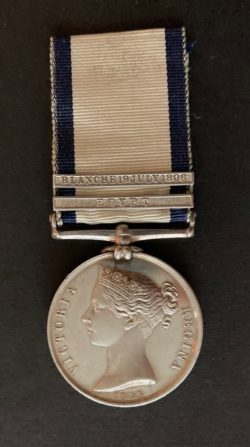 Naval General Service, 2 clasps, Egypt, Blanche 19 July 1806, A rare officers medal (Purser.) 22 clasps issued, (11 extant)
Naval General Service, 2 clasps, Egypt, Blanche 19 July 1806, A rare officers medal (Purser.) 22 clasps issued, (11 extant) 